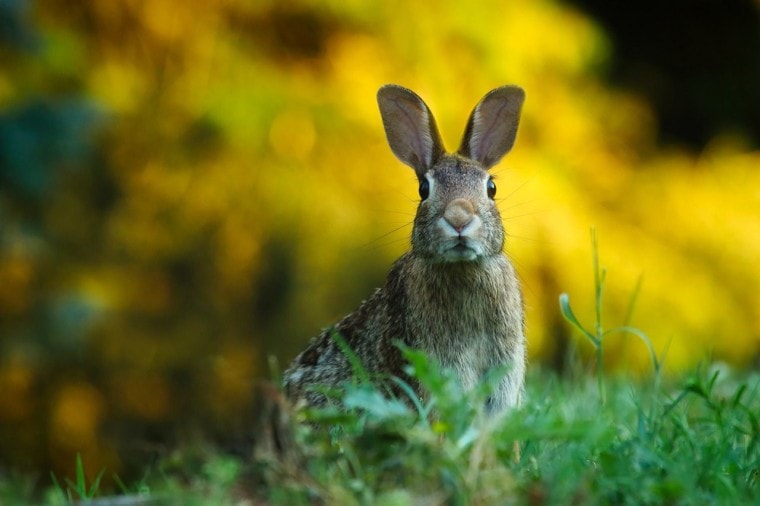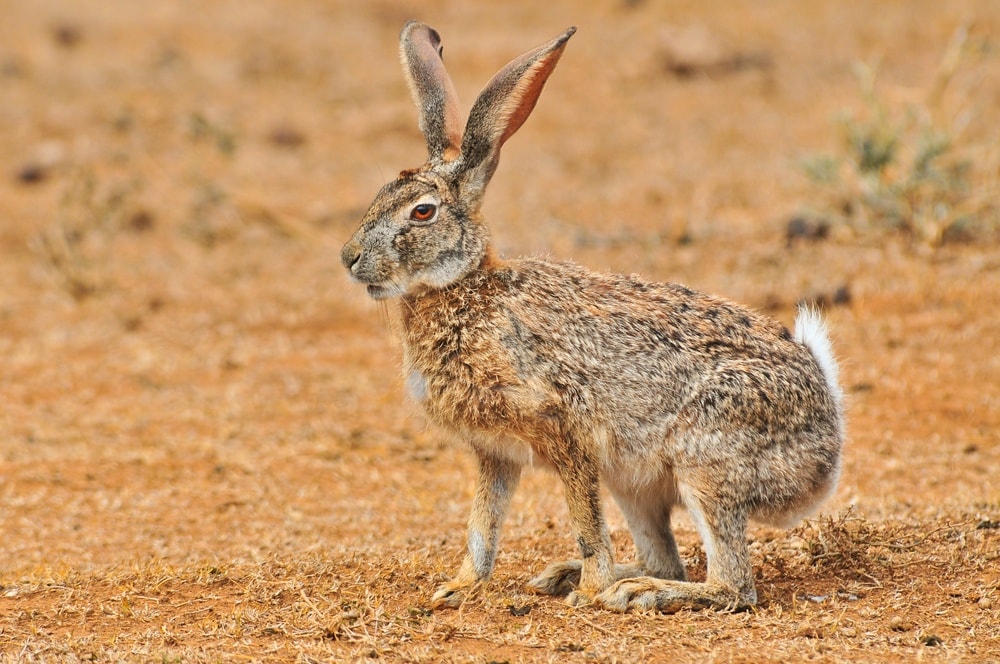
Click to Skip Ahead
The Scrub Hare is not a domesticated animal and is only found living in the wild throughout Africa, specifically in places like Namibia, Lesotho, and Eswatini. Scrub hares have long ears and legs, so they can easily hear and run from predators that might be on their trail.
Scrub Hares are born with open eyes and fur, so they can get along on their own right away. Their parents don’t stick around to care for them, which makes them vulnerable to predators. Read on to learn more about the Scrub Hare!
Breed Overview
Size:
18–26 inches long
Weight:
3.3 – 9 pounds
Lifespan:
1 – 5 years
Similar Breeds:
Cape hare, Polish Rabbit
Suitable for:
The wild
Temperament:
Solitary, wary
Scrub Hares have existed for at least 45,000 years! However, since they can only be found in Southern Africa, other parts of the world hardly ever hear about them. Depending on where they are in South Africa, the hares belong to one of three separate lineages. For instance, Scrub Hares living in the southwest Cape of Africa belong to one particular lineage, but those living in northern South African regions do not.
In this species, females are typically bigger than males. The color of Scrub hares is particularly distinctive, which helps them blend into their surroundings. Their fur is grizzled gray with tiny black dots on the dorsal side, but the fur is all white on the ventral side.
Scrub hares are most noticeable when racing away from predators because of their long, gray ears, which are usually perched up. Scrub hares prefer to live in open spaces instead of forests and other densely wooded places. This helps them observe their surroundings and gain a head start if they notice a predator nearby.
Scrub Hare Characteristics
Temperament & Intelligence of the Scrub Hare Rabbit

The Scrub Hare is a solitary animal that prefers to live alone except during mating season. They are nocturnal and usually do their foraging at night. They are very aloof, independent, and alert. With their large ears, scrub hares can detect a predator approaching them from a distance and outrun any threat because of their long, strong legs.
They will run at incredible speeds in a zig-zag pattern to escape danger, which confuses predators and makes it difficult for them to keep up.
Do These Rabbits Make Good Pets?
Despite being as cute as a bunny, Scrub Hares are not domesticated creatures and do not make good pets. Scrub Hares are wild animals, and that’s where they should stay to remain happy and healthy. Even if you locate a wild rabbit as a baby, their instincts to escape predators will remain unaltered; therefore, you will never be able to properly domesticate or tame one, and you will never be able to form a bond with a Scrub Hare.
Does This Rabbit Get Along With Other Animals?
While rabbits are social animals and often live in groups, hares are solitary and prefer to live alone. This includes the Scrub Hare, which only pairs up with another hare during mating season.
They can also be seen together when the babies are with their mothers through the most sensitive times of their development. When adult males unexpectedly cross paths or interact with them, some get hostile. During the mating season, when all males compete for a partner, their hostility may intensify.
Things to Know About Scrub Hares
Food & Diet
Scrub hares are herbivores and usually feed on green grass. However, due to their harsh environment, that is not always possible. They will eat grass stems, leaves, and rhizomes during dry spells when there is less green grass, and they will even eat shrub bark to survive.
Habitat
Southern Africa is the Scrub hare’s natural habitat. They are in South Africa, Lesotho, Swaziland, and Northern Namibia. They have also been reported in Zambia, Malawi, Nigeria, Senegal, Uganda, Kenya, Angola, Mozambique, and Southeast Ethiopia.
Instead of woods, the areas in South Africa where the Scrub hare inhabits have open fields. They can even live on developed agricultural lands. However, they are adaptive creatures. All they require for a habitat are grassy areas and adequate shelter to hide from local predators during the day.
Population Threats
Development, commercial plantations, and habitat fragmentation are the main threats to Scrub hares. All of this results in the destruction of their habitats and exposes them to predators. The hunting of Scrub hares is also a threat to their population. They are frequently hunted by locals for food, and their plush, warm fur is occasionally used to make gloves.
In KwaZulu-Natal, South Africa, there has been a population drop due to hunting. They also serve as food for creatures like Side-striped jackals, cheetahs, caracals, and several predatory birds. Since they blend into their surroundings, predators cannot see them as long as they are motionless.
The Scrub hare jumps and runs away as quickly as possible using their long rear legs at the last second. Despite being a species of least concern, its population has declined and is projected to do so for the next 100 years by 20%.

Mating Habits
Since scrub hares are polygynous, numerous males will congregate around a female to mate with her during mating season. Males typically compete by kicking with their hind legs or “boxing” with their forefeet to win the female over. Although scrub hares can give birth at any time of the year, the peak period is from September to February.
An average female gives birth to one to three babies at a time throughout the approximately 42-day gestation period. Triplets are more prevalent during a wet season, but severe drought conditions won’t stop them from reproducing.
The young take care of themselves after they’re born. The parents do not offer them resources or safety, and they do not provide any learning opportunities. Even while the mother may breastfeed her young at night, it does not last long. At 1 year of age, Scrub Hares normally attain reproductive maturity.
Male vs Female
Female Scrub Hares are usually bigger than the males because she has longer hind legs and a longer body. Males may become more hostile during mating season, but other than that, there is not much more difference between the sexes.
3 Little-Known Facts About Scrub Hares
1. Scrub Hares Have Many Roles in the Ecosystem
Scrub hares play several roles in the ecosystem. They assist in breaking up the ground and redistributing the soil, contributing to a small degree of soil aeration. This affects the growth of vegetation and provides food for larger animals. They also act as hosts for numerous flea and lice species.
2. Scrub Hares Process Their Feces Twice
These incredible grazers consume green foliage, which results in oval-shaped, pale green to yellow droppings. They excrete their feces and then eat it to absorb all the nutrients. Coprophagia is the name for this peculiar behavior.
3. Scrub Hares Are Great at Hiding
Scrub Hares create a little dent in the ground and lie flat and immobile with their ears pushed back to their shoulders to conceal themselves from predators throughout the day. As a result, they become more difficult for predators to spot due to their coloration, which blends with their surroundings.
Conclusion
The scrub hare is a fascinating creature that merits our attention, but we should only observe and appreciate them from their natural habitat in the wild. Scrub Hares are not domesticated like rabbits and cannot be tamed or kept as pets. They are solitary, nocturnal animals only seen together during mating season. Their babies are born to be independent from the moment they are born and are often only paired with their mothers during feeding.
They are also fast little creatures that can quickly escape predators with their long legs and confuse them by running in a zig-zag route. Their coloration also blends into their surroundings and helps them evade predators as long as they are motionless. Despite being a species of least concern, their population continues to decline due to hunting and land development.
See Also:
Featured Image Credit: David Mark, Pixabay








